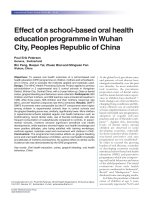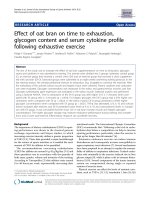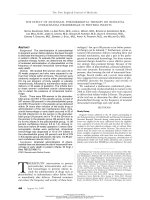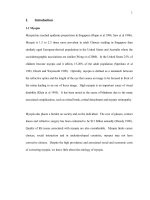Effect of Choline chloride on in vitro rumen fermentation of oat hay based TMR’s varying in energy levels
Bạn đang xem bản rút gọn của tài liệu. Xem và tải ngay bản đầy đủ của tài liệu tại đây (262.88 KB, 7 trang )
Int.J.Curr.Microbiol.App.Sci (2019) 8(5): 2238-2244
International Journal of Current Microbiology and Applied Sciences
ISSN: 2319-7706 Volume 8 Number 05 (2019)
Journal homepage:
Original Research Article
/>
Effect of Choline Chloride on in vitro Rumen Fermentation of Oat Hay
based TMR’s Varying in Energy Levels
D.K. Gupta, R.S. Grewal*, J.S. Lamba and Simarjit Kaur
Department of Animal Nutrition, GADVASU, India
Directorate of Livestock Farms, GADVASU, Ludhiana, India
*Corresponding author
ABSTRACT
Keywords
Choline, Rumen
fermentation, in
vitro gas production
Article Info
Accepted:
18 April 2019
Available Online:
10 May 2019
Present study was conducted to see the effect of different levels (0, 50, 75 and 100 ppm of
concentrate) of choline chloride on in vitro fermentation process with rations of different
energy content. Two rations were prepared having different energy levels (1.26 Mcal/kg
NEL and 1.50 Mcal/kg NEL) and both these rations were supplemented with different
levels (0, 50, 75 and 100 ppm of concentrate) of choline chloride to see the effect of
choline No significant effect of either choline supplementation at different levels was
found on any in vitro parameter as compared to control diets with either low or high
energy content of ration. On comparison of in vitro results obtained by supplementation of
choline chloride irrespective of the level of supplemented choline chloride with low and
high energy diets, significant differences in various parameters were obtained at 5% level
of significance. NGP, ME, OMD, %OMD, TD and short chain fatty acids were
significantly higher for high energy diet (P<0.05) whereas MMP and EMMP were found
significantly higher for low energy diet. These results lead to the conclusions that choline
does not have any significant role on rumen fermentation process.
Introduction
There are reports (Dyer et al., 1966 and
Swingle and Dyer, 1970) which suggest that
choline in unprotected form has favorable
effect on rumen fermentationFeedstuffs for
dairy cattle contain free choline and
phosphatidylcholine but content of these
compounds in plants is relatively small and
their ruminal degradation is extensive
(Sharma and Erdman, 1989) so their intestinal
supply is not enough to meet tissue
requirements for dairy cows. Mean estimates
of rumen degradable choline (%) were 79.4,
84.7, 82.9, 83.8, 98.0, and 98.6 for barley,
cottonseed meal, fish meal, soybean meal,
choline stearate, and choline chloride
respectively (Sharma and Erdman, 1989).
Microbial populations in the rumen quickly
degrade rationary choline; therefore practical
means of increasing choline to the
periparturient dairy cows is to feed it in a
rumen-protected form (Atkins et al., 1988).
Erdman and Sharma (1991) told that rumen
protected choline used is very less degraded
by rumen microbes and remains stable for
2238
Int.J.Curr.Microbiol.App.Sci (2019) 8(5): 2238-2244
maximum availability in the intestine of
animal. Mohsen et al., (2011) did not find any
change in ruminal fermentation on
supplementation of ration with RPC at 15 or
30g/day. The objective of this study was to
see effect of different levels of choline in
unprotected form or in the form of Rumen
Proctected Choline (RPC) on in vitro
fermentation process when supplemented
with low (1.26 Mcal/kg NEL) as well as high
(1.50 Mcal/kg NEL) energy levels of ration.
Materials and Methods
In this study two rations were prepared which
were isonitrogenous but different in their net
energy of lactation (NEL) content. One ration
was having low (1.26Mcal/kg NEL) content
while other was having high (1.50Mcal/kg
NEL) content. Different concentrations of
choline and Rumen Protected Choline (RPC)
used in various experiments were 0, 500, 750
and 1000mg per 100g of concentrate or
equivalent to 0, 50, 75, and 100ppm of
concentrate. Composition of the two rations
was:
Two rations of different energy levels were
supplemented with different concentrations
(0, 50, 75, and 100ppm of concentrate) of
choline in 1st experiment and with different
concentrations of bypass choline in 2nd
experiment. In 3rd experiment different
concentrations of either choline or RPC were
supplemented with same low energy level of
the ration and in 4thexpriment different
concentrations of either choline or RPC were
supplemented with same high energy level of
the ration.
In vitro gas production technique
Thein vitro gas production was done
according to Menke and Steingass (1988).
The amount of gas produced was used to
calculate the ME (Metabolizable energy)
value. NDF of the residue was also
determined. Total degradable sample(TDS),
Organic matter degradability (OMD),
Partition factor (PF), % Organic matter
degradability (% OMD), % Neutral detergent
fibre degradability (% NDFD), Microbial
mass production (MMP), Efficiency of
microbial mass production (EMMP), True
digestibility (TD) and Short chain fatty acids
were calculated according to formulae
suggested by (Makkar, 2003). Crude Protein
Degradability (CPD) was estimated according
to method suggested by Raab et al., (1983).
Volaltile fatty acids (VFAs) were estimated
using Gas Liquid Chromatography (GLC)
technique.
Data were analysed using SPSS software by
applying statistical designs including one-way
ANOVA and Paired t-test at 5% level of
significance.
Results and Discussion
When choline was supplemented in
unprotected form at different levels (0, 50, 75
and 100)ppm with only low energy diet, no
significant difference was observed at 5%
level of significance in any parameter except
PF (P>0.05). PF value was significantly
higher (P<0.05) at 75ppm level than 100ppm
level and values at other two levels (0,
50)ppm were similar to PF values at both
these levels. We may conclude from this
result that 75ppm level of choline chloride is
more suitable for utilisation of low energy
feed by the animal than higher level. But none
of the three level used for choline chloride
showed significant difference from control
with respect to PF or any other parameter
which shows no significant effect of different
levels of choline chloride with low energy
diet on rumen fermentation process.
When choline at different levels (0, 50, 75,
100) ppm was supplemented along with high
2239
Int.J.Curr.Microbiol.App.Sci (2019) 8(5): 2238-2244
energy diet in in vitro experiment, no
significant difference (P>0.05) was observed
in any parameter at 5% level of significance.
However non significant differences were
there and PF, MMP and EMMP values were
found maximum for diet supplemented with
100ppm choline. These results show that there
is no significant effect of different levels of
choline chloride on rumen fermentation
process with high energy levels of diet though
there may be some non significant increase in
the feed utilization at 100 ppm level of
choline.
For choline chloride supplemented in
different concentrations (0, 500, 750 or 1000)
mg/100g (or 0, 50, 75 and 100)ppm of
concentrate and irrespective of the energy
level of diet, no significant difference was
found for any of the above measured
parameters during in vitro study. These results
contradict any significant role of choline for
rumen microbes as suggested by some
scientists (Dyer et al., 1966, Sharma and
Erdman 1988). Althoghnon significant
changes were there in NGP, %NDFD, OMD,
TD which first increases with choline addition
and then decreases at higher choline
concentration. EMMP in all the treatment
diets was non significantly less than control
that avoids any role of choline for microbial
growth in the rumen. PF was although
maximum for 75ppm level of choline
however at lower or higher levels it is less
than control that does not lead to any
conclusion. All these results (from Table 1, 2
and 3) suggest that there is no significant
effect of choline chloride on rumen
fermentation process. These results are in
agreement to Rumsey (1985) who found no
effect of choline supplementation on rumen
fermentation parameters like VFAs, Rumen
pH, ammonia and lactic acid isomer changes
on all concentrate ration. However these
results are in contradiction to the results found
in some previous studies (Dyer et al., 1966,
Sharma and Erdman 1988) where it was
suggested that choline improves microbial
performance in rumen.
Table.1 Composition of TMR’s used in experiment
Ingredients
Low Energy
40
Oat Hay
20
Wheat Straw
6
Maize
10.5
Soya bean Meal
5.5
Mustard Cake
6
Cotton seed Meal
10.5
D.O.R.B.
0.5
M.M.
1
Salt
Chemical Composition, % DM basis
16.067
CP
29.6
NDF
36.9
ADF
1.833
EE
10.01
ASH
1.26
Estimated
ME,
Mcal/Kg
2240
High Energy
50
-19
10
3.5
2.5
13.5
0.5
1
16.003
23.1
30.3
4.033
9.96
1.50
Int.J.Curr.Microbiol.App.Sci (2019) 8(5): 2238-2244
Table.2 Results of in vitro experiment for diets supplemented with different levels of choline
chloride with low energy level (1.26 Mcal/kg) of diet
Parameter
NGP(ml)
ME
(MJ/kg of
DM)
TDS (mg)
OMD (mg)
PF(mg/ml)
OMD (%)
NDFD (%)
MMP
(mg)
EMMP
(%)
TD (%)
Short
chain FA
(mmol)
Control
74.58±2.48
8.16 ±0.17
50 ppm
72.92±0.93
8.018±0.08
75 ppm
74.75±0.76
8.214±0.08
100 ppm
74.75±1.32
8.19±0.15
329.37±2.328
234.21 ± 0.51
3.24 ±0.07ab
71.37 ± 0.91
57.78±1.35
165.29 ±3.97
329.67±1.05
238.39±6.69
3.24± 0.04ab
72.16±2.31
58.95 ± 3.41
169.25±2.41
327.34±1.01
246.21±0.87
3.33±0.001a
75.02±0.07
63.16±0.10
162.889 ± 2.53
328.79±2.78
230.97±6.12
3.04±0.05b
70.74±1.31
56.85±1.93
164.34±5.11
72.27 ± 0.24
70.87±3.69
67.18±0.11
68.99±1.41
72.75±1.17
1.61± 0.05
73.85±1.75
1.57±0.02
76.46±0.46
1.62±0.02
72.04±1.69
1.62±0.03
Different superscripts in row vary significantly at 5% level of significance
Table.3 Results of in vitro experiment for diets supplemented with different levels of choline
chloride with high energy level (1.50 Mcal/kg) of diet
Parameter2
NGP(ml)
ME (MJ/kg of
DM)
TDS (mg)
OMD (mg)
PF(mg/ml)
OMD (%)
NDFD (%)
MMP (mg)
EMMP (%)
TD (%)
Short
chain
FA (mmol)
Control
82.25±1.00
9.31±0.13
50 ppm
82.25±1.32
9.34±0.09
75 ppm
83.08±0.17
9.40±0.05
100 ppm
80.08±1.36
9.07±0.12
327.92±2.54
269.46±5.12
3.32±0.06
81.66±0.90
65.34±1.71
146.97±4.50
56.12±0.09
82.80±0.93
1.78±0.02
326.76±1.16
270.84±0.25
3.29±0.09
82.74±0.37
67.39±0.69
145.81±1.85
53.85±1.23
83.74±0.71
1.78±0.03
327.05±2.10
271.09±2.88
3.27±0.03
83.27±1.56
68.40±2.94
144.26±2.23
52.76±1.73
83.93±1.75
1.80±0.01
331.12±0.77
272.20±2.37
3.46±0.01
82.06±0.50
66.11±0.94
154.94±3.52
58.22±0.55
82.37±0.57
1.74±0.03
2241
Int.J.Curr.Microbiol.App.Sci (2019) 8(5): 2238-2244
Table.4 Results of in vitro experiment for diets supplemented with different levels of choline
chloride, irrespective of the energy level of diet
Parameter
Control
50 ppm
75 ppm
100 ppm
NGP(ml)
78.42±2.09
77.58±2.21
78.92±1.90
77.42±3.59
8.68±0.30
8.81±0.27
8.63±0.21
ME (MJ/kg of 8.74±0.28
DM)
TDS (mg)
328.65±1.57
328.21±0.96
327.19±1.04
329.96±1.39
OMD (mg)
251.83±10.39
254.62±9.76
258.65±7.29
251.58±12.20
PF(mg/ml)
3.28±0.05
3.26±0.04
3.30±0.02
3.25±0.12
OMD (%)
76.51±3.11
77.45±3.20
79.15±2.47
76.40±3.32
NDFD (%)
61.56±2.36
63.17±2.82
65.78±1.93
61.48±2.81
MMP (mg)
156.13±4.90
157.53±5.42
153.58±4.43
159.64±3.48
EMMP (%)
64.19±4.66
62.36±5.16
59.97±4.22
63.06±3.17
TD (%)
77.77±2.96
78.79±2.96
80.20±2.28
77.21±3.07
1.68±0.05
1.71±0.04
1.68±0.03
Short
chain 1.70±0.05
FA (mmol)
Table.5 Comparison of high and low energy diets supplemented with choline chloride in vitro
for various parameters irrespective of the level of supplemented choline chloride
Parameter
Low energy diet
a
High energy diet
81.91±0.57 b
NGP(ml)
74.25±0.69
ME (MJ/kg of DM)
8.14±0.06 a
9.28±0.06 b
TDS (mg)
328.79 ± 0.88
328.21±0.92
OMD (mg)
237.45±0.76 a
270.90±1.25 b
PF(mg/ml)
3.21±0.04
3.33±0.04
OMD (%)
72.32±0.82 a
82.43±0.43 b
NDFD (%)
59.19±1.20
66.81±0.81
b
148.00±0 1.85 a
MMP (mg)
165.83±1.72
EMMP (%)
69.83±1.04 b
55.24±0.90 a
TD (%)
73.78±0.82 a
83.21±0.48 b
Short chain
(mmol)
FA 1.61±0.02 a
1.78±0.01 b
Different superscripts in row vary significantly at 5% level of significance
2242
Int.J.Curr.Microbiol.App.Sci (2019) 8(5): 2238-2244
Table.6 Results of in vitro experiment for diets supplemented with different levels of choline
chloride with low energy level (1.26 Mcal/kg) of diet
Parameter
NGP(ml)
ME (MJ/kg
of DM)
TDS (mg)
OMD (mg)
PF(mg/ml)
OMD (%)
NDFD (%)
MMP (mg)
EMMP (%)
TD (%)
Short chain
FA (mmol)
Group 1
74.58±2.48
8.16±0.17
Group 2
72.917±0.93
8.0178±0.08
Group 3
74.75±0.76
8.21±0.08
Group 4
74.75±1.32
8.188±147
329.37±2.32
234.21±0.51
3.24±0.07ab
71.37±0.91
57.78±1.35
165.29±3.97
72.269±0.24
72.75±1.17
1.61±0.05
329.67±1.05
238.39±6.69
3.24±0.04ab
72.16±2.31
58.95±3.41
169.25±2.41
70.87± 3.69
73.85±1.75
1.58±0.02
327.34±1.01
246.21±0.87
3.33±0.01a
75.02±0.07
63.16±0.10
162.89±2.53
67.18±0.11
76.46±0.46
1.62±0.02
328.79±2.78
230.97±6.12
3.04±0.051b
70.74±1.31
56.85±1.93
164.34±5.11
68.99±1.41
72.04±1.695
1.62±0.03
Table.7 In vitro parameters for high Energy diet supplemented with choline irrespective of the
level of supplemented Choline
Parameter
NGP(ml)
ME (MJ/kg of DM)
TDS (mg)
OMD (mg)
PF(mg/ml)
OMD (%)
NDFD (%)
MMP (mg)
EMMP (%)
TD (%)
Short chain FA (mmol)
Control
76.50± 1.78
8.82±0.14
329.09±0.43
268.33±1.79
3.50±0.08
81.60±0.64
65.21±1.22
159.71±5.16
59.58±2.42
82.20±0.34
1.66±0.06
On comparison of in vitro results obtained by
supplementation of choline chloride irrespective
of the level of supplemented choline chloride
with low and high energy diets, significant
differences in various parameters were obtained
at 5% level of significance. NGP, ME, OMD,
%OMD, TD and short chain fatty acids were
significantly higher for high energy diet
(P<0.05) whereas MMP and EMMP were found
significantly higher for low energy diet. These
results show more proportion of highly
With Choline Chloride
73.75±1.43
8.64±0.11
330.50±4.55
268.04±1.62
3.58±0.095
81.71±0.33
65.42±0.63
163.15±3.98
60.86±1.36
82.21±0.36
1.62±0.04
degradable substances and less fibre content in
high energy diet (Makkar, 2003).
No significant difference was there for any of
the above measured parameters between high
energy diets supplemented with choline at 5%
level of significance (P>0.05). However PF,
MMP and EMMP were found non significantly
higher for choline chloride supplemented diets
than control diets that shows some beneficial
effect of Choline chloride on microbial
2243
Int.J.Curr.Microbiol.App.Sci (2019) 8(5): 2238-2244
performance for high energy diets(P>0.05)
(Table 4–7).
From all these in vitro experiments we may
conclude that choline supplementation does not
affect rumen fermentation process significantly
with either low energy or high energy levels of
ration. As it was suggested in many experiments
previously (Atkins et al., 1988; Sharma and
Erdman 1989) that choline chloride in
unprotected form is quickly degraded to a very
high extent, so there is no use to supplement
choline in unprotected form in the diet of dairy
cows.
References
Atkins K B, Erdman R A, and Vandersall J H.
1988. Dietary choline effects of milk
yield and duodenal choline flow in dairy
cattle. J. Dairy Sci. 71:109-116.
Bygrave F L and Dawson R M C. 1976.
Phosphatidylcholine biosynthesis and
choline transport in the anaerobic
protozoan
Entodenium
caudatum.
Biochem. Journal 160:481-490.
Dyer I A, Johnson R J, and templeton J. 1966.
Are mature cattle getting their choline
needs? Feed Age 16, No. 6.
Erdman R A, Shaver R D, and Vandersall J H.
1984. Dietary choline for the lactating
cow: possible effects on milk fat
synthesis. Journal of Dairy Science
67:410-415.
Erdman R A, and Sharma B K. 1991.Effect of
Dietary Rumen-Protected Choline in
Lactating Dairy Cows. J. Dairy Sci.
74:1641-1647.
Guozhong Xu, Jun’An Ye, JianxinLiu and
Yueying Yu. 2006. Effect of Rumenprotected Choline Addition on Milk
Performance and Blood Metabolic
Parameters in Transition Dairy Cows.
Asian-Aust. J. Anim. Sci. 19:390-395.
Makkar H P S. 2004. Recent advances in the in
vitro gas method for evaluation of
nutritional quality of feed resources. In:
Assessing Quality and Safety of Animal
Feeds. FAO Animal Production and
Health Series 160. FAO, Rome, pp. 55–
88
Menke K H and Steingass H. 1988. Estimation
of the energetic feed value obtained from
chemical analysis and in vitro gas
production using rumen fluid. Animal
Research and Development 28:7-55.
Mohsen M K, Gaafar H M A, Khalafalla M M,
Shitta A A, Yousif A M. 2011. Effect of
rumen protected choline supplementation
on digestibility, rumen activity and milk
yield in lactating Friesian cows. Journal
of Animal Science 44:13-20.
Neil A R, Grime D W, and Dawson R M C.
1978. Conversion of choline methyl
group through trimethylamine into
methane in the rumen. Biochem.
Journal170:529-535.
Rumsey T S. 1985. Effect of choline in all
concentrate diets of feedlot steers and on
ruminal acidosis. Canadian Journal of
Animal Science65(1): 135-146.
Sharma, B.K., and R.A. Erdman.1988a.
Abomasal infusion of choline and
methionine with or without 2-amino-2methyl-l-propanol for lactating dairy
cows.J. Dairy Sci. 71: 2406-2411.
Sharma B K, and Erdman R A. 1989. Effects of
dietary and abomasally infused choline on
milk production responses of lactating
dairy cows. Journal of Nutrition 119:248254.
Swingle R S, and Dyer I A. 1970. Effects of
choline on rumen microbial metabolism.
Journal of animal science 31:404-408.
How to cite this article:
Gupta, D.K., R.S. Grewal, J.S. Lamba and Simarjit Kaur. 2019. Effect of Choline Chloride on in
vitro Rumen Fermentation of Oat Hay based TMR’s Varying in Energy Levels.
Int.J.Curr.Microbiol.App.Sci. 8(05): 2238-2244. doi: />
2244









